Research Proposal: Analysis of Two-Phase Evaporative Cooling System
VerifiedAdded on 2022/10/17
|18
|5716
|9
Project
AI Summary
This research proposal outlines the development of a future two-phase evaporative cooling system, targeting applications in the automotive and power generation sectors. It addresses the increasing demand for efficient cooling solutions due to rising energy consumption and environmental concerns associated with traditional cooling methods. The proposal details the project's objectives, which include experimentally investigating heat and mass transfer processes during pool and flow boiling using high-speed optical diagnostics, and developing accurate models for predicting heat flux and surface temperature distributions. The document also covers the background and significance of the research, highlighting the advantages of two-phase evaporative cooling over conventional systems, current research trends, and ethical considerations. The expected outcomes include advancements in understanding nucleate boiling, critical heat flux, and rewetting phenomena. The project aims to contribute to the development of compact, efficient, and environmentally friendly cooling technologies for future energy systems.
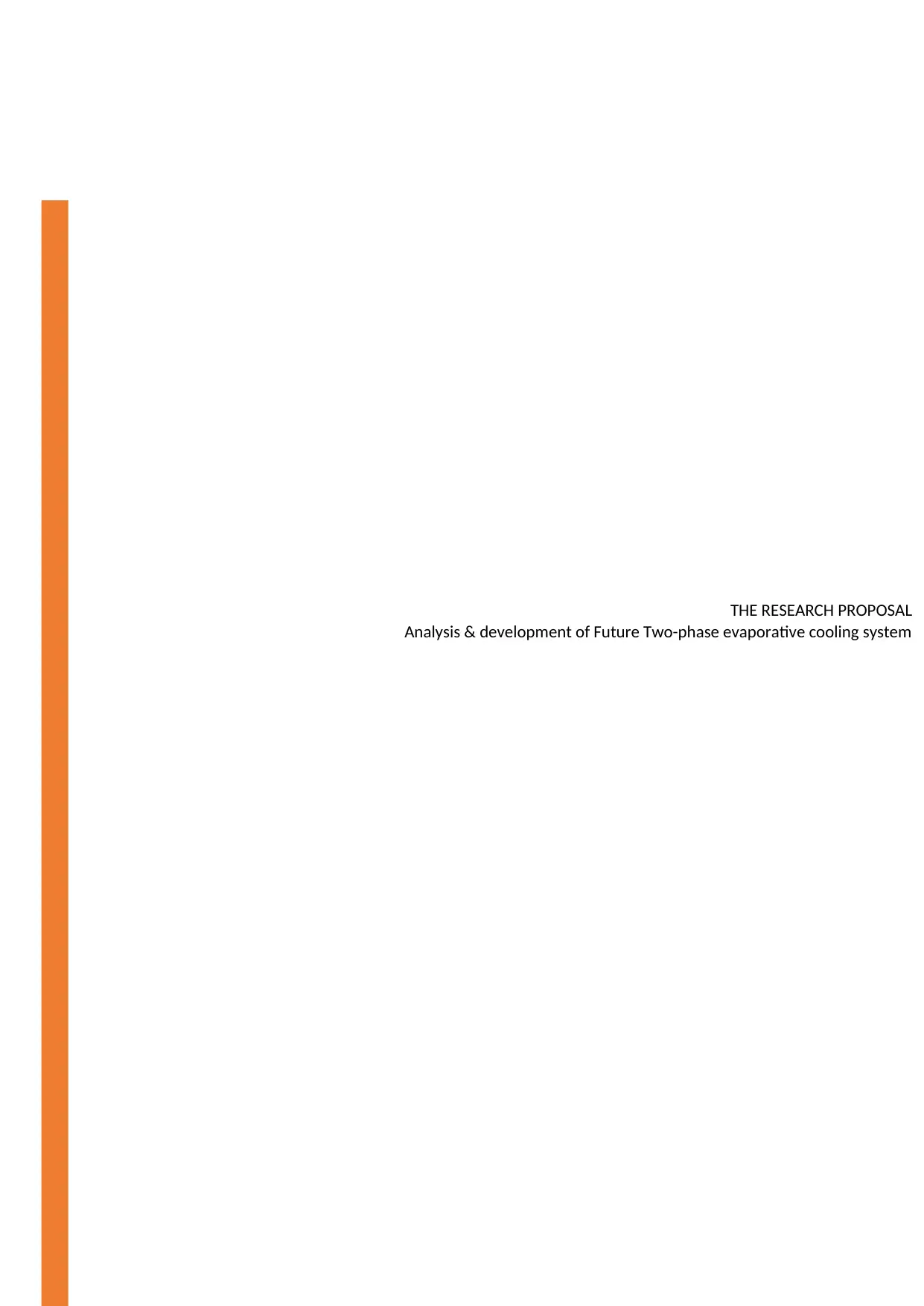
THE RESEARCH PROPOSAL
Analysis & development of Future Two-phase evaporative cooling system
Analysis & development of Future Two-phase evaporative cooling system
Paraphrase This Document
Need a fresh take? Get an instant paraphrase of this document with our AI Paraphraser
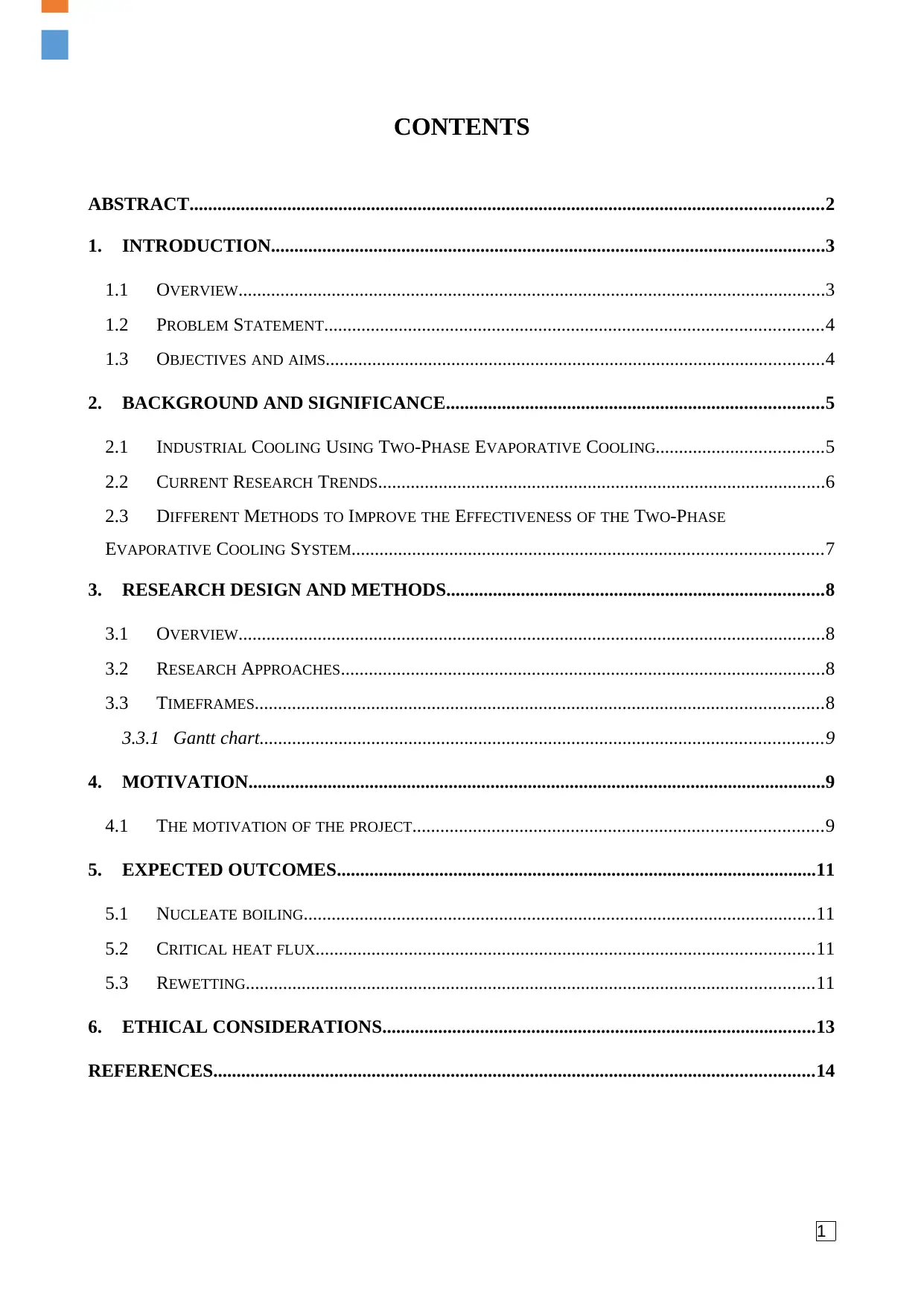
CONTENTS
ABSTRACT........................................................................................................................................2
1. INTRODUCTION.......................................................................................................................3
1.1 OVERVIEW..............................................................................................................................3
1.2 PROBLEM STATEMENT...........................................................................................................4
1.3 OBJECTIVES AND AIMS...........................................................................................................4
2. BACKGROUND AND SIGNIFICANCE.................................................................................5
2.1 INDUSTRIAL COOLING USING TWO-PHASE EVAPORATIVE COOLING....................................5
2.2 CURRENT RESEARCH TRENDS................................................................................................6
2.3 DIFFERENT METHODS TO IMPROVE THE EFFECTIVENESS OF THE TWO-PHASE
EVAPORATIVE COOLING SYSTEM.....................................................................................................7
3. RESEARCH DESIGN AND METHODS.................................................................................8
3.1 OVERVIEW..............................................................................................................................8
3.2 RESEARCH APPROACHES........................................................................................................8
3.3 TIMEFRAMES..........................................................................................................................8
3.3.1 Gantt chart.........................................................................................................................9
4. MOTIVATION............................................................................................................................9
4.1 THE MOTIVATION OF THE PROJECT........................................................................................9
5. EXPECTED OUTCOMES.......................................................................................................11
5.1 NUCLEATE BOILING..............................................................................................................11
5.2 CRITICAL HEAT FLUX...........................................................................................................11
5.3 REWETTING..........................................................................................................................11
6. ETHICAL CONSIDERATIONS.............................................................................................13
REFERENCES.................................................................................................................................14
1
ABSTRACT........................................................................................................................................2
1. INTRODUCTION.......................................................................................................................3
1.1 OVERVIEW..............................................................................................................................3
1.2 PROBLEM STATEMENT...........................................................................................................4
1.3 OBJECTIVES AND AIMS...........................................................................................................4
2. BACKGROUND AND SIGNIFICANCE.................................................................................5
2.1 INDUSTRIAL COOLING USING TWO-PHASE EVAPORATIVE COOLING....................................5
2.2 CURRENT RESEARCH TRENDS................................................................................................6
2.3 DIFFERENT METHODS TO IMPROVE THE EFFECTIVENESS OF THE TWO-PHASE
EVAPORATIVE COOLING SYSTEM.....................................................................................................7
3. RESEARCH DESIGN AND METHODS.................................................................................8
3.1 OVERVIEW..............................................................................................................................8
3.2 RESEARCH APPROACHES........................................................................................................8
3.3 TIMEFRAMES..........................................................................................................................8
3.3.1 Gantt chart.........................................................................................................................9
4. MOTIVATION............................................................................................................................9
4.1 THE MOTIVATION OF THE PROJECT........................................................................................9
5. EXPECTED OUTCOMES.......................................................................................................11
5.1 NUCLEATE BOILING..............................................................................................................11
5.2 CRITICAL HEAT FLUX...........................................................................................................11
5.3 REWETTING..........................................................................................................................11
6. ETHICAL CONSIDERATIONS.............................................................................................13
REFERENCES.................................................................................................................................14
1
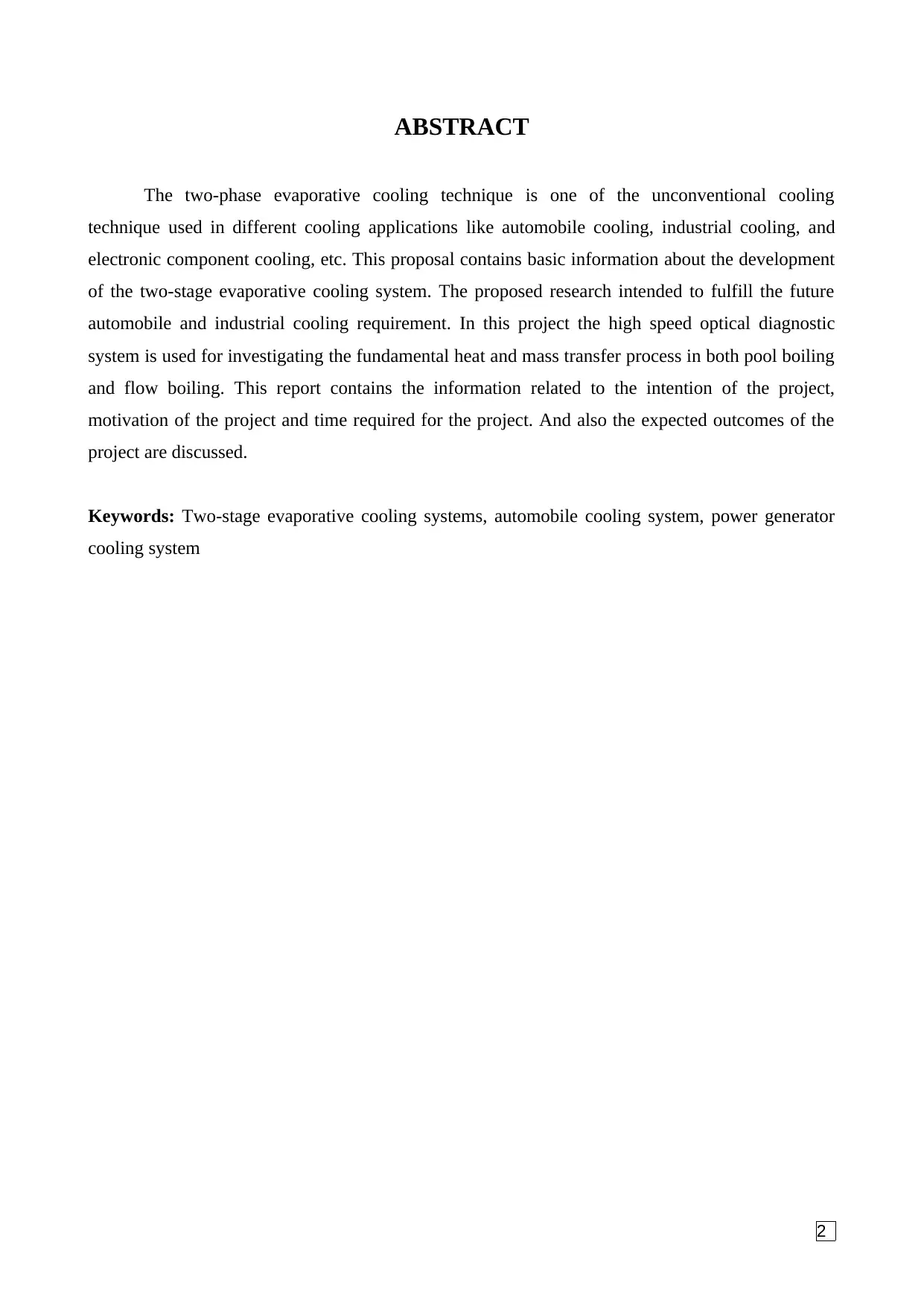
ABSTRACT
The two-phase evaporative cooling technique is one of the unconventional cooling
technique used in different cooling applications like automobile cooling, industrial cooling, and
electronic component cooling, etc. This proposal contains basic information about the development
of the two-stage evaporative cooling system. The proposed research intended to fulfill the future
automobile and industrial cooling requirement. In this project the high speed optical diagnostic
system is used for investigating the fundamental heat and mass transfer process in both pool boiling
and flow boiling. This report contains the information related to the intention of the project,
motivation of the project and time required for the project. And also the expected outcomes of the
project are discussed.
Keywords: Two-stage evaporative cooling systems, automobile cooling system, power generator
cooling system
2
The two-phase evaporative cooling technique is one of the unconventional cooling
technique used in different cooling applications like automobile cooling, industrial cooling, and
electronic component cooling, etc. This proposal contains basic information about the development
of the two-stage evaporative cooling system. The proposed research intended to fulfill the future
automobile and industrial cooling requirement. In this project the high speed optical diagnostic
system is used for investigating the fundamental heat and mass transfer process in both pool boiling
and flow boiling. This report contains the information related to the intention of the project,
motivation of the project and time required for the project. And also the expected outcomes of the
project are discussed.
Keywords: Two-stage evaporative cooling systems, automobile cooling system, power generator
cooling system
2
⊘ This is a preview!⊘
Do you want full access?
Subscribe today to unlock all pages.

Trusted by 1+ million students worldwide
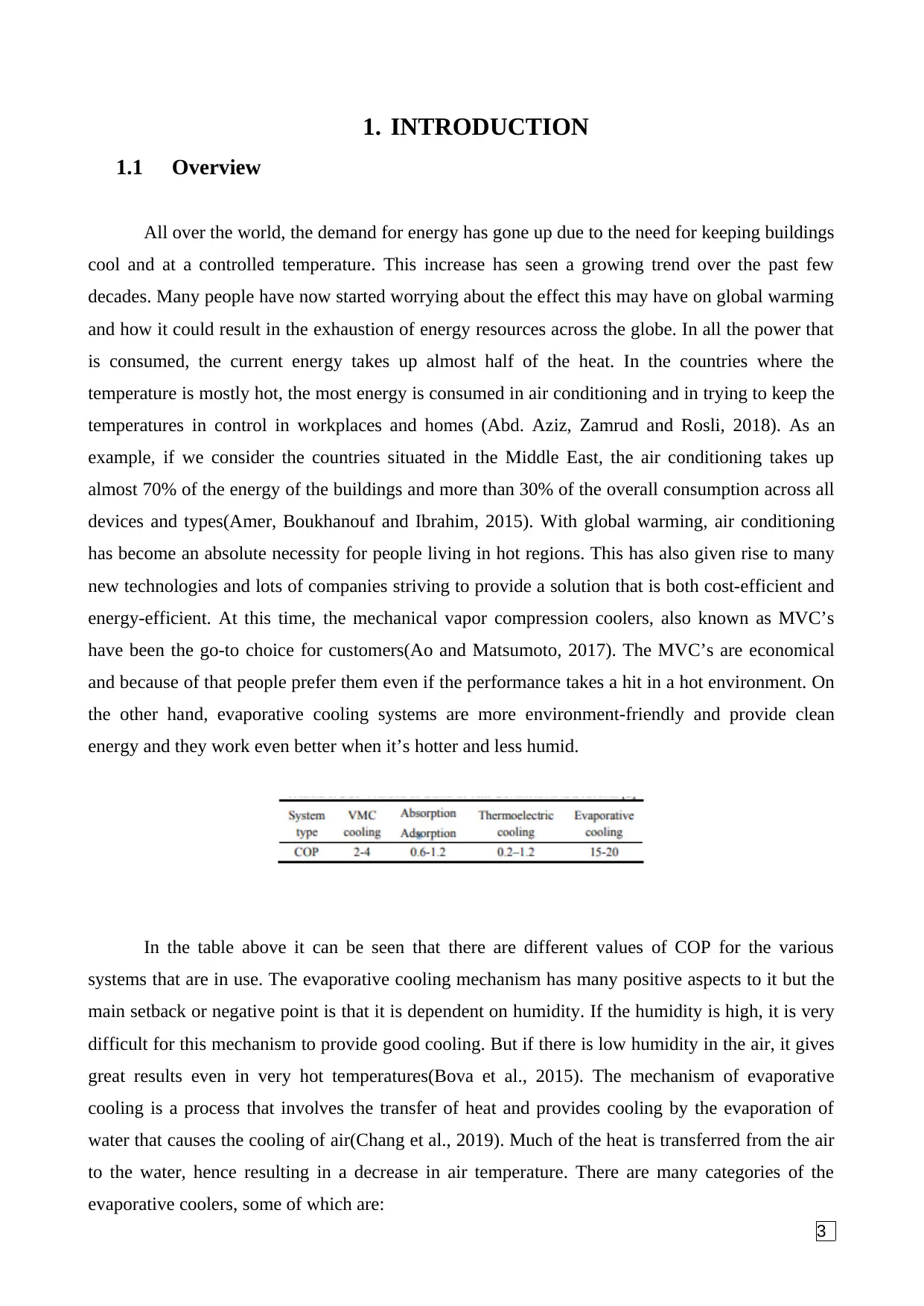
1. INTRODUCTION
1.1 Overview
All over the world, the demand for energy has gone up due to the need for keeping buildings
cool and at a controlled temperature. This increase has seen a growing trend over the past few
decades. Many people have now started worrying about the effect this may have on global warming
and how it could result in the exhaustion of energy resources across the globe. In all the power that
is consumed, the current energy takes up almost half of the heat. In the countries where the
temperature is mostly hot, the most energy is consumed in air conditioning and in trying to keep the
temperatures in control in workplaces and homes (Abd. Aziz, Zamrud and Rosli, 2018). As an
example, if we consider the countries situated in the Middle East, the air conditioning takes up
almost 70% of the energy of the buildings and more than 30% of the overall consumption across all
devices and types(Amer, Boukhanouf and Ibrahim, 2015). With global warming, air conditioning
has become an absolute necessity for people living in hot regions. This has also given rise to many
new technologies and lots of companies striving to provide a solution that is both cost-efficient and
energy-efficient. At this time, the mechanical vapor compression coolers, also known as MVC’s
have been the go-to choice for customers(Ao and Matsumoto, 2017). The MVC’s are economical
and because of that people prefer them even if the performance takes a hit in a hot environment. On
the other hand, evaporative cooling systems are more environment-friendly and provide clean
energy and they work even better when it’s hotter and less humid.
In the table above it can be seen that there are different values of COP for the various
systems that are in use. The evaporative cooling mechanism has many positive aspects to it but the
main setback or negative point is that it is dependent on humidity. If the humidity is high, it is very
difficult for this mechanism to provide good cooling. But if there is low humidity in the air, it gives
great results even in very hot temperatures(Bova et al., 2015). The mechanism of evaporative
cooling is a process that involves the transfer of heat and provides cooling by the evaporation of
water that causes the cooling of air(Chang et al., 2019). Much of the heat is transferred from the air
to the water, hence resulting in a decrease in air temperature. There are many categories of the
evaporative coolers, some of which are:
3
1.1 Overview
All over the world, the demand for energy has gone up due to the need for keeping buildings
cool and at a controlled temperature. This increase has seen a growing trend over the past few
decades. Many people have now started worrying about the effect this may have on global warming
and how it could result in the exhaustion of energy resources across the globe. In all the power that
is consumed, the current energy takes up almost half of the heat. In the countries where the
temperature is mostly hot, the most energy is consumed in air conditioning and in trying to keep the
temperatures in control in workplaces and homes (Abd. Aziz, Zamrud and Rosli, 2018). As an
example, if we consider the countries situated in the Middle East, the air conditioning takes up
almost 70% of the energy of the buildings and more than 30% of the overall consumption across all
devices and types(Amer, Boukhanouf and Ibrahim, 2015). With global warming, air conditioning
has become an absolute necessity for people living in hot regions. This has also given rise to many
new technologies and lots of companies striving to provide a solution that is both cost-efficient and
energy-efficient. At this time, the mechanical vapor compression coolers, also known as MVC’s
have been the go-to choice for customers(Ao and Matsumoto, 2017). The MVC’s are economical
and because of that people prefer them even if the performance takes a hit in a hot environment. On
the other hand, evaporative cooling systems are more environment-friendly and provide clean
energy and they work even better when it’s hotter and less humid.
In the table above it can be seen that there are different values of COP for the various
systems that are in use. The evaporative cooling mechanism has many positive aspects to it but the
main setback or negative point is that it is dependent on humidity. If the humidity is high, it is very
difficult for this mechanism to provide good cooling. But if there is low humidity in the air, it gives
great results even in very hot temperatures(Bova et al., 2015). The mechanism of evaporative
cooling is a process that involves the transfer of heat and provides cooling by the evaporation of
water that causes the cooling of air(Chang et al., 2019). Much of the heat is transferred from the air
to the water, hence resulting in a decrease in air temperature. There are many categories of the
evaporative coolers, some of which are:
3
Paraphrase This Document
Need a fresh take? Get an instant paraphrase of this document with our AI Paraphraser
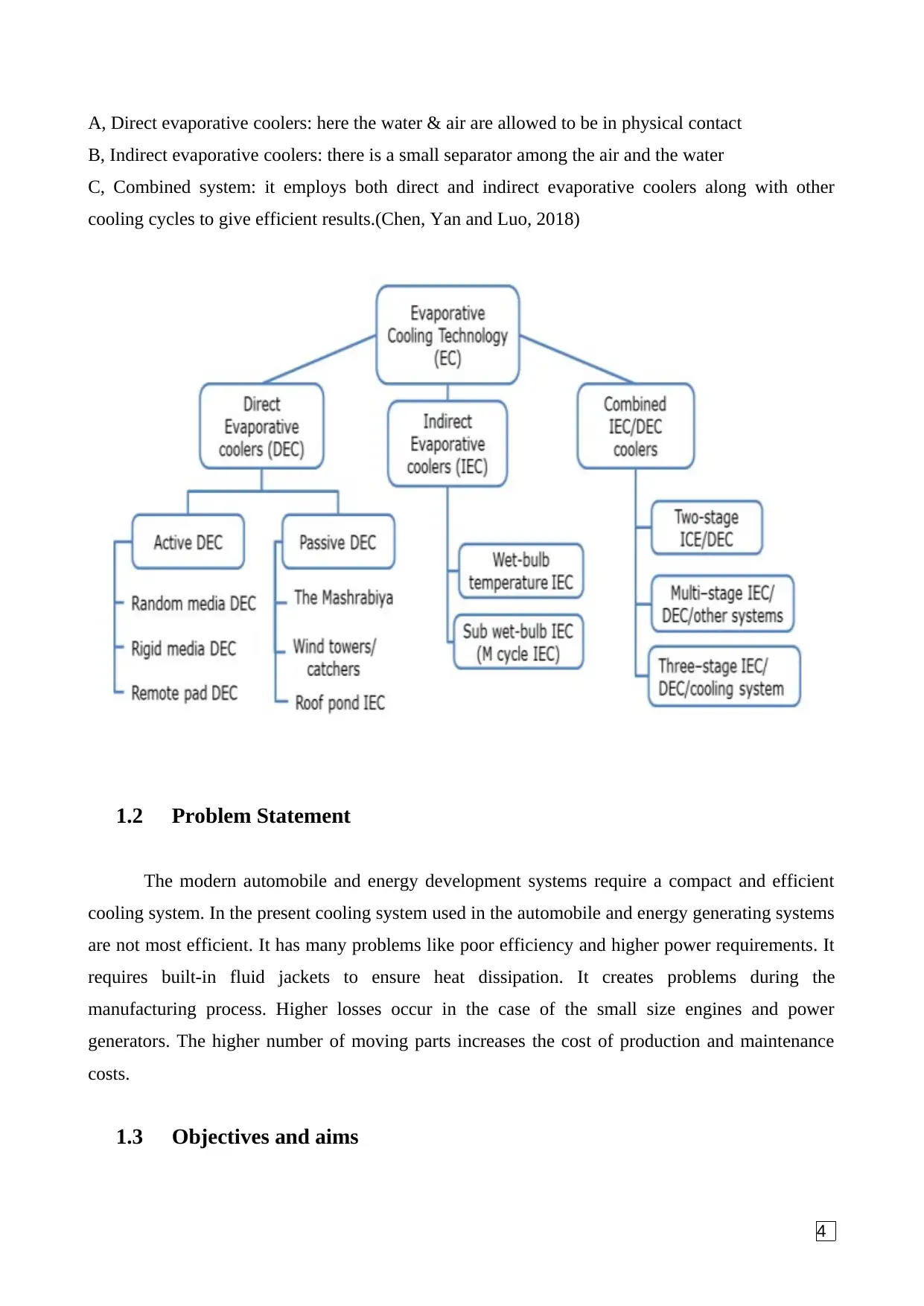
A, Direct evaporative coolers: here the water & air are allowed to be in physical contact
B, Indirect evaporative coolers: there is a small separator among the air and the water
C, Combined system: it employs both direct and indirect evaporative coolers along with other
cooling cycles to give efficient results.(Chen, Yan and Luo, 2018)
1.2 Problem Statement
The modern automobile and energy development systems require a compact and efficient
cooling system. In the present cooling system used in the automobile and energy generating systems
are not most efficient. It has many problems like poor efficiency and higher power requirements. It
requires built-in fluid jackets to ensure heat dissipation. It creates problems during the
manufacturing process. Higher losses occur in the case of the small size engines and power
generators. The higher number of moving parts increases the cost of production and maintenance
costs.
1.3 Objectives and aims
4
B, Indirect evaporative coolers: there is a small separator among the air and the water
C, Combined system: it employs both direct and indirect evaporative coolers along with other
cooling cycles to give efficient results.(Chen, Yan and Luo, 2018)
1.2 Problem Statement
The modern automobile and energy development systems require a compact and efficient
cooling system. In the present cooling system used in the automobile and energy generating systems
are not most efficient. It has many problems like poor efficiency and higher power requirements. It
requires built-in fluid jackets to ensure heat dissipation. It creates problems during the
manufacturing process. Higher losses occur in the case of the small size engines and power
generators. The higher number of moving parts increases the cost of production and maintenance
costs.
1.3 Objectives and aims
4
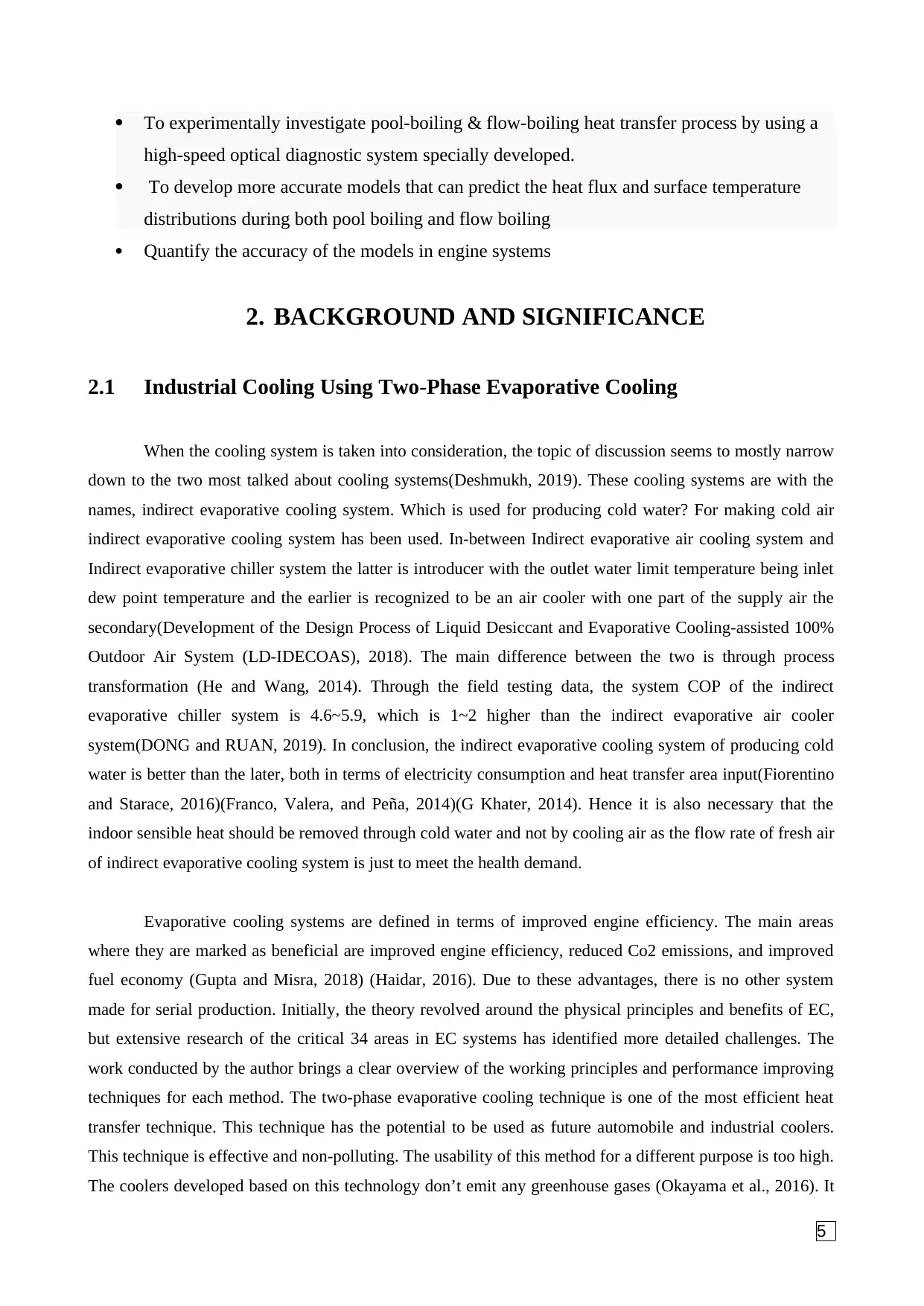
To experimentally investigate pool-boiling & flow-boiling heat transfer process by using a
high-speed optical diagnostic system specially developed.
To develop more accurate models that can predict the heat flux and surface temperature
distributions during both pool boiling and flow boiling
Quantify the accuracy of the models in engine systems
2. BACKGROUND AND SIGNIFICANCE
2.1 Industrial Cooling Using Two-Phase Evaporative Cooling
When the cooling system is taken into consideration, the topic of discussion seems to mostly narrow
down to the two most talked about cooling systems(Deshmukh, 2019). These cooling systems are with the
names, indirect evaporative cooling system. Which is used for producing cold water? For making cold air
indirect evaporative cooling system has been used. In-between Indirect evaporative air cooling system and
Indirect evaporative chiller system the latter is introducer with the outlet water limit temperature being inlet
dew point temperature and the earlier is recognized to be an air cooler with one part of the supply air the
secondary(Development of the Design Process of Liquid Desiccant and Evaporative Cooling-assisted 100%
Outdoor Air System (LD-IDECOAS), 2018). The main difference between the two is through process
transformation (He and Wang, 2014). Through the field testing data, the system COP of the indirect
evaporative chiller system is 4.6~5.9, which is 1~2 higher than the indirect evaporative air cooler
system(DONG and RUAN, 2019). In conclusion, the indirect evaporative cooling system of producing cold
water is better than the later, both in terms of electricity consumption and heat transfer area input(Fiorentino
and Starace, 2016)(Franco, Valera, and Peña, 2014)(G Khater, 2014). Hence it is also necessary that the
indoor sensible heat should be removed through cold water and not by cooling air as the flow rate of fresh air
of indirect evaporative cooling system is just to meet the health demand.
Evaporative cooling systems are defined in terms of improved engine efficiency. The main areas
where they are marked as beneficial are improved engine efficiency, reduced Co2 emissions, and improved
fuel economy (Gupta and Misra, 2018) (Haidar, 2016). Due to these advantages, there is no other system
made for serial production. Initially, the theory revolved around the physical principles and benefits of EC,
but extensive research of the critical 34 areas in EC systems has identified more detailed challenges. The
work conducted by the author brings a clear overview of the working principles and performance improving
techniques for each method. The two-phase evaporative cooling technique is one of the most efficient heat
transfer technique. This technique has the potential to be used as future automobile and industrial coolers.
This technique is effective and non-polluting. The usability of this method for a different purpose is too high.
The coolers developed based on this technology don’t emit any greenhouse gases (Okayama et al., 2016). It
5
high-speed optical diagnostic system specially developed.
To develop more accurate models that can predict the heat flux and surface temperature
distributions during both pool boiling and flow boiling
Quantify the accuracy of the models in engine systems
2. BACKGROUND AND SIGNIFICANCE
2.1 Industrial Cooling Using Two-Phase Evaporative Cooling
When the cooling system is taken into consideration, the topic of discussion seems to mostly narrow
down to the two most talked about cooling systems(Deshmukh, 2019). These cooling systems are with the
names, indirect evaporative cooling system. Which is used for producing cold water? For making cold air
indirect evaporative cooling system has been used. In-between Indirect evaporative air cooling system and
Indirect evaporative chiller system the latter is introducer with the outlet water limit temperature being inlet
dew point temperature and the earlier is recognized to be an air cooler with one part of the supply air the
secondary(Development of the Design Process of Liquid Desiccant and Evaporative Cooling-assisted 100%
Outdoor Air System (LD-IDECOAS), 2018). The main difference between the two is through process
transformation (He and Wang, 2014). Through the field testing data, the system COP of the indirect
evaporative chiller system is 4.6~5.9, which is 1~2 higher than the indirect evaporative air cooler
system(DONG and RUAN, 2019). In conclusion, the indirect evaporative cooling system of producing cold
water is better than the later, both in terms of electricity consumption and heat transfer area input(Fiorentino
and Starace, 2016)(Franco, Valera, and Peña, 2014)(G Khater, 2014). Hence it is also necessary that the
indoor sensible heat should be removed through cold water and not by cooling air as the flow rate of fresh air
of indirect evaporative cooling system is just to meet the health demand.
Evaporative cooling systems are defined in terms of improved engine efficiency. The main areas
where they are marked as beneficial are improved engine efficiency, reduced Co2 emissions, and improved
fuel economy (Gupta and Misra, 2018) (Haidar, 2016). Due to these advantages, there is no other system
made for serial production. Initially, the theory revolved around the physical principles and benefits of EC,
but extensive research of the critical 34 areas in EC systems has identified more detailed challenges. The
work conducted by the author brings a clear overview of the working principles and performance improving
techniques for each method. The two-phase evaporative cooling technique is one of the most efficient heat
transfer technique. This technique has the potential to be used as future automobile and industrial coolers.
This technique is effective and non-polluting. The usability of this method for a different purpose is too high.
The coolers developed based on this technology don’t emit any greenhouse gases (Okayama et al., 2016). It
5
⊘ This is a preview!⊘
Do you want full access?
Subscribe today to unlock all pages.

Trusted by 1+ million students worldwide
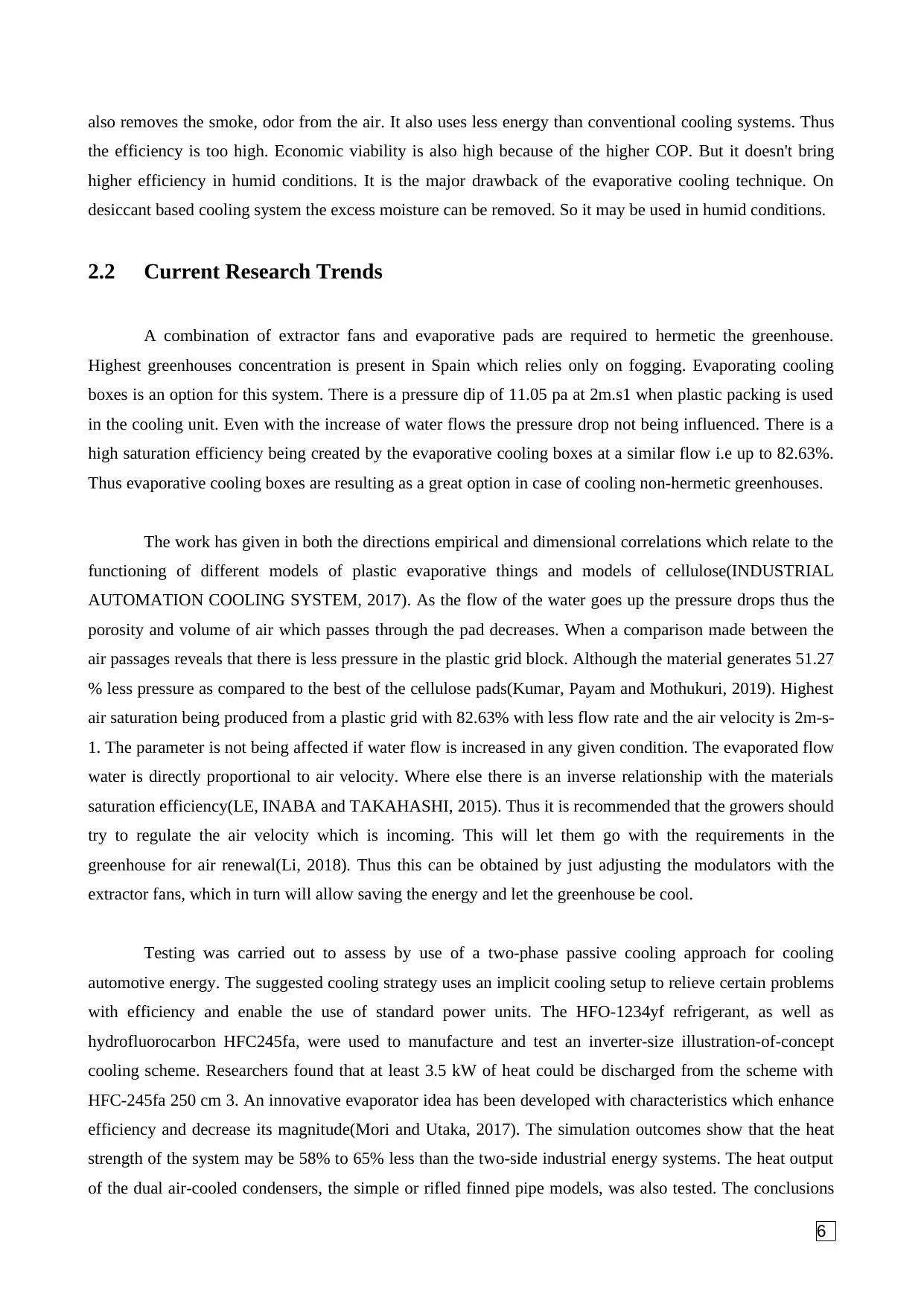
also removes the smoke, odor from the air. It also uses less energy than conventional cooling systems. Thus
the efficiency is too high. Economic viability is also high because of the higher COP. But it doesn't bring
higher efficiency in humid conditions. It is the major drawback of the evaporative cooling technique. On
desiccant based cooling system the excess moisture can be removed. So it may be used in humid conditions.
2.2 Current Research Trends
A combination of extractor fans and evaporative pads are required to hermetic the greenhouse.
Highest greenhouses concentration is present in Spain which relies only on fogging. Evaporating cooling
boxes is an option for this system. There is a pressure dip of 11.05 pa at 2m.s1 when plastic packing is used
in the cooling unit. Even with the increase of water flows the pressure drop not being influenced. There is a
high saturation efficiency being created by the evaporative cooling boxes at a similar flow i.e up to 82.63%.
Thus evaporative cooling boxes are resulting as a great option in case of cooling non-hermetic greenhouses.
The work has given in both the directions empirical and dimensional correlations which relate to the
functioning of different models of plastic evaporative things and models of cellulose(INDUSTRIAL
AUTOMATION COOLING SYSTEM, 2017). As the flow of the water goes up the pressure drops thus the
porosity and volume of air which passes through the pad decreases. When a comparison made between the
air passages reveals that there is less pressure in the plastic grid block. Although the material generates 51.27
% less pressure as compared to the best of the cellulose pads(Kumar, Payam and Mothukuri, 2019). Highest
air saturation being produced from a plastic grid with 82.63% with less flow rate and the air velocity is 2m-s-
1. The parameter is not being affected if water flow is increased in any given condition. The evaporated flow
water is directly proportional to air velocity. Where else there is an inverse relationship with the materials
saturation efficiency(LE, INABA and TAKAHASHI, 2015). Thus it is recommended that the growers should
try to regulate the air velocity which is incoming. This will let them go with the requirements in the
greenhouse for air renewal(Li, 2018). Thus this can be obtained by just adjusting the modulators with the
extractor fans, which in turn will allow saving the energy and let the greenhouse be cool.
Testing was carried out to assess by use of a two-phase passive cooling approach for cooling
automotive energy. The suggested cooling strategy uses an implicit cooling setup to relieve certain problems
with efficiency and enable the use of standard power units. The HFO-1234yf refrigerant, as well as
hydrofluorocarbon HFC245fa, were used to manufacture and test an inverter-size illustration-of-concept
cooling scheme. Researchers found that at least 3.5 kW of heat could be discharged from the scheme with
HFC-245fa 250 cm 3. An innovative evaporator idea has been developed with characteristics which enhance
efficiency and decrease its magnitude(Mori and Utaka, 2017). The simulation outcomes show that the heat
strength of the system may be 58% to 65% less than the two-side industrial energy systems. The heat output
of the dual air-cooled condensers, the simple or rifled finned pipe models, was also tested. The conclusions
6
the efficiency is too high. Economic viability is also high because of the higher COP. But it doesn't bring
higher efficiency in humid conditions. It is the major drawback of the evaporative cooling technique. On
desiccant based cooling system the excess moisture can be removed. So it may be used in humid conditions.
2.2 Current Research Trends
A combination of extractor fans and evaporative pads are required to hermetic the greenhouse.
Highest greenhouses concentration is present in Spain which relies only on fogging. Evaporating cooling
boxes is an option for this system. There is a pressure dip of 11.05 pa at 2m.s1 when plastic packing is used
in the cooling unit. Even with the increase of water flows the pressure drop not being influenced. There is a
high saturation efficiency being created by the evaporative cooling boxes at a similar flow i.e up to 82.63%.
Thus evaporative cooling boxes are resulting as a great option in case of cooling non-hermetic greenhouses.
The work has given in both the directions empirical and dimensional correlations which relate to the
functioning of different models of plastic evaporative things and models of cellulose(INDUSTRIAL
AUTOMATION COOLING SYSTEM, 2017). As the flow of the water goes up the pressure drops thus the
porosity and volume of air which passes through the pad decreases. When a comparison made between the
air passages reveals that there is less pressure in the plastic grid block. Although the material generates 51.27
% less pressure as compared to the best of the cellulose pads(Kumar, Payam and Mothukuri, 2019). Highest
air saturation being produced from a plastic grid with 82.63% with less flow rate and the air velocity is 2m-s-
1. The parameter is not being affected if water flow is increased in any given condition. The evaporated flow
water is directly proportional to air velocity. Where else there is an inverse relationship with the materials
saturation efficiency(LE, INABA and TAKAHASHI, 2015). Thus it is recommended that the growers should
try to regulate the air velocity which is incoming. This will let them go with the requirements in the
greenhouse for air renewal(Li, 2018). Thus this can be obtained by just adjusting the modulators with the
extractor fans, which in turn will allow saving the energy and let the greenhouse be cool.
Testing was carried out to assess by use of a two-phase passive cooling approach for cooling
automotive energy. The suggested cooling strategy uses an implicit cooling setup to relieve certain problems
with efficiency and enable the use of standard power units. The HFO-1234yf refrigerant, as well as
hydrofluorocarbon HFC245fa, were used to manufacture and test an inverter-size illustration-of-concept
cooling scheme. Researchers found that at least 3.5 kW of heat could be discharged from the scheme with
HFC-245fa 250 cm 3. An innovative evaporator idea has been developed with characteristics which enhance
efficiency and decrease its magnitude(Mori and Utaka, 2017). The simulation outcomes show that the heat
strength of the system may be 58% to 65% less than the two-side industrial energy systems. The heat output
of the dual air-cooled condensers, the simple or rifled finned pipe models, was also tested. The conclusions
6
Paraphrase This Document
Need a fresh take? Get an instant paraphrase of this document with our AI Paraphraser
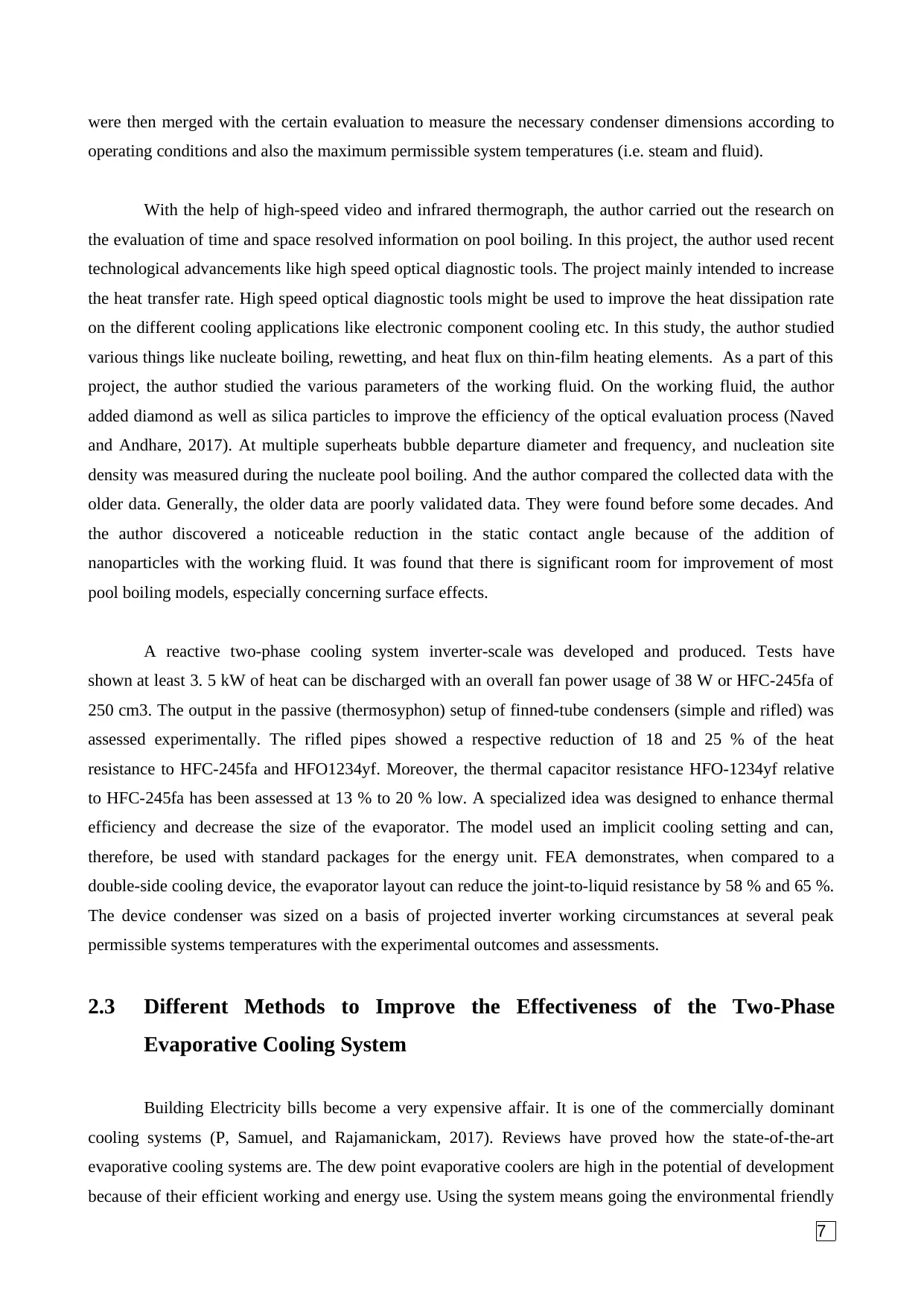
were then merged with the certain evaluation to measure the necessary condenser dimensions according to
operating conditions and also the maximum permissible system temperatures (i.e. steam and fluid).
With the help of high-speed video and infrared thermograph, the author carried out the research on
the evaluation of time and space resolved information on pool boiling. In this project, the author used recent
technological advancements like high speed optical diagnostic tools. The project mainly intended to increase
the heat transfer rate. High speed optical diagnostic tools might be used to improve the heat dissipation rate
on the different cooling applications like electronic component cooling etc. In this study, the author studied
various things like nucleate boiling, rewetting, and heat flux on thin-film heating elements. As a part of this
project, the author studied the various parameters of the working fluid. On the working fluid, the author
added diamond as well as silica particles to improve the efficiency of the optical evaluation process (Naved
and Andhare, 2017). At multiple superheats bubble departure diameter and frequency, and nucleation site
density was measured during the nucleate pool boiling. And the author compared the collected data with the
older data. Generally, the older data are poorly validated data. They were found before some decades. And
the author discovered a noticeable reduction in the static contact angle because of the addition of
nanoparticles with the working fluid. It was found that there is significant room for improvement of most
pool boiling models, especially concerning surface effects.
A reactive two-phase cooling system inverter-scale was developed and produced. Tests have
shown at least 3. 5 kW of heat can be discharged with an overall fan power usage of 38 W or HFC-245fa of
250 cm3. The output in the passive (thermosyphon) setup of finned-tube condensers (simple and rifled) was
assessed experimentally. The rifled pipes showed a respective reduction of 18 and 25 % of the heat
resistance to HFC-245fa and HFO1234yf. Moreover, the thermal capacitor resistance HFO-1234yf relative
to HFC-245fa has been assessed at 13 % to 20 % low. A specialized idea was designed to enhance thermal
efficiency and decrease the size of the evaporator. The model used an implicit cooling setting and can,
therefore, be used with standard packages for the energy unit. FEA demonstrates, when compared to a
double-side cooling device, the evaporator layout can reduce the joint-to-liquid resistance by 58 % and 65 %.
The device condenser was sized on a basis of projected inverter working circumstances at several peak
permissible systems temperatures with the experimental outcomes and assessments.
2.3 Different Methods to Improve the Effectiveness of the Two-Phase
Evaporative Cooling System
Building Electricity bills become a very expensive affair. It is one of the commercially dominant
cooling systems (P, Samuel, and Rajamanickam, 2017). Reviews have proved how the state-of-the-art
evaporative cooling systems are. The dew point evaporative coolers are high in the potential of development
because of their efficient working and energy use. Using the system means going the environmental friendly
7
operating conditions and also the maximum permissible system temperatures (i.e. steam and fluid).
With the help of high-speed video and infrared thermograph, the author carried out the research on
the evaluation of time and space resolved information on pool boiling. In this project, the author used recent
technological advancements like high speed optical diagnostic tools. The project mainly intended to increase
the heat transfer rate. High speed optical diagnostic tools might be used to improve the heat dissipation rate
on the different cooling applications like electronic component cooling etc. In this study, the author studied
various things like nucleate boiling, rewetting, and heat flux on thin-film heating elements. As a part of this
project, the author studied the various parameters of the working fluid. On the working fluid, the author
added diamond as well as silica particles to improve the efficiency of the optical evaluation process (Naved
and Andhare, 2017). At multiple superheats bubble departure diameter and frequency, and nucleation site
density was measured during the nucleate pool boiling. And the author compared the collected data with the
older data. Generally, the older data are poorly validated data. They were found before some decades. And
the author discovered a noticeable reduction in the static contact angle because of the addition of
nanoparticles with the working fluid. It was found that there is significant room for improvement of most
pool boiling models, especially concerning surface effects.
A reactive two-phase cooling system inverter-scale was developed and produced. Tests have
shown at least 3. 5 kW of heat can be discharged with an overall fan power usage of 38 W or HFC-245fa of
250 cm3. The output in the passive (thermosyphon) setup of finned-tube condensers (simple and rifled) was
assessed experimentally. The rifled pipes showed a respective reduction of 18 and 25 % of the heat
resistance to HFC-245fa and HFO1234yf. Moreover, the thermal capacitor resistance HFO-1234yf relative
to HFC-245fa has been assessed at 13 % to 20 % low. A specialized idea was designed to enhance thermal
efficiency and decrease the size of the evaporator. The model used an implicit cooling setting and can,
therefore, be used with standard packages for the energy unit. FEA demonstrates, when compared to a
double-side cooling device, the evaporator layout can reduce the joint-to-liquid resistance by 58 % and 65 %.
The device condenser was sized on a basis of projected inverter working circumstances at several peak
permissible systems temperatures with the experimental outcomes and assessments.
2.3 Different Methods to Improve the Effectiveness of the Two-Phase
Evaporative Cooling System
Building Electricity bills become a very expensive affair. It is one of the commercially dominant
cooling systems (P, Samuel, and Rajamanickam, 2017). Reviews have proved how the state-of-the-art
evaporative cooling systems are. The dew point evaporative coolers are high in the potential of development
because of their efficient working and energy use. Using the system means going the environmental friendly
7
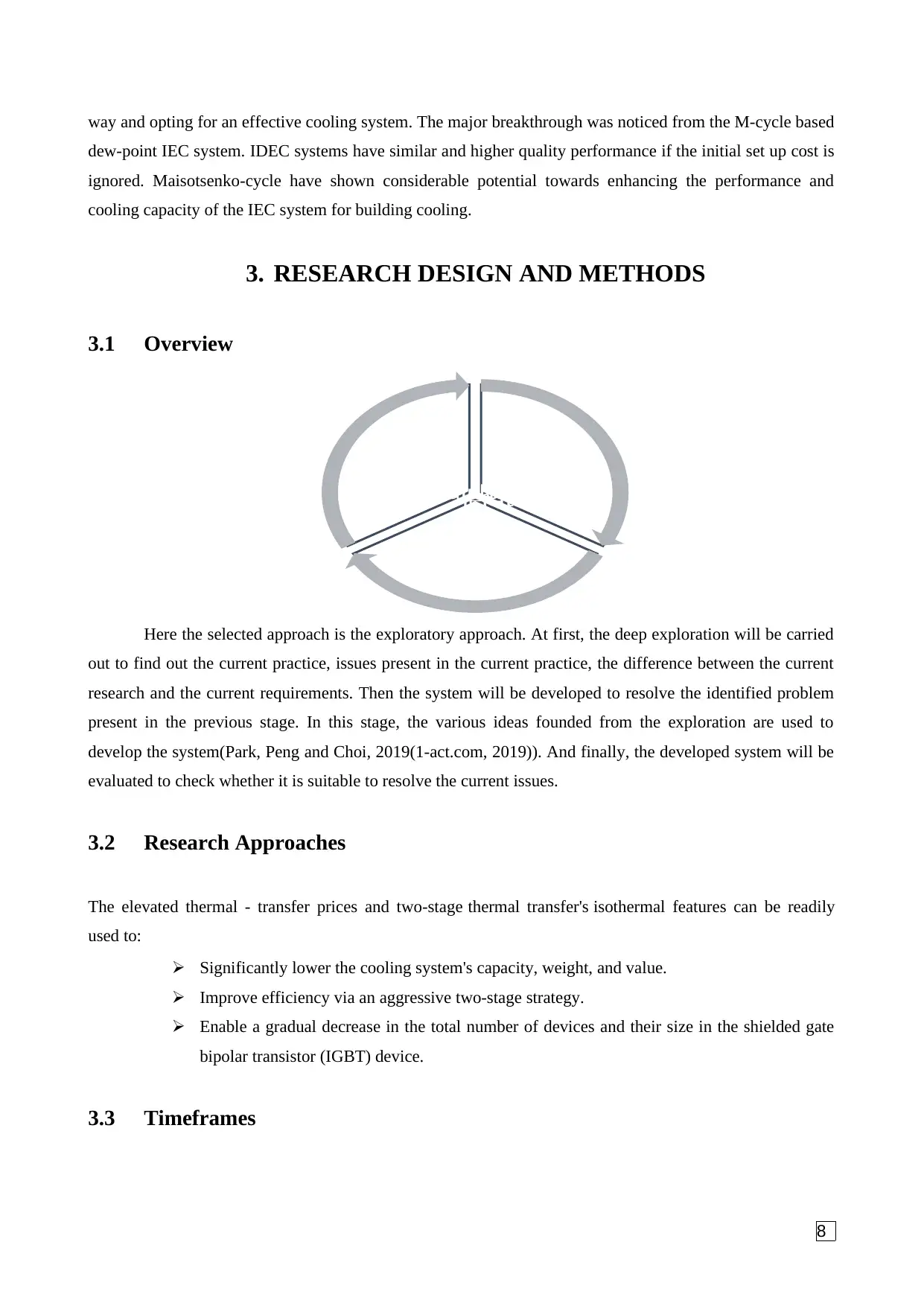
way and opting for an effective cooling system. The major breakthrough was noticed from the M-cycle based
dew-point IEC system. IDEC systems have similar and higher quality performance if the initial set up cost is
ignored. Maisotsenko-cycle have shown considerable potential towards enhancing the performance and
cooling capacity of the IEC system for building cooling.
3. RESEARCH DESIGN AND METHODS
3.1 Overview
Here the selected approach is the exploratory approach. At first, the deep exploration will be carried
out to find out the current practice, issues present in the current practice, the difference between the current
research and the current requirements. Then the system will be developed to resolve the identified problem
present in the previous stage. In this stage, the various ideas founded from the exploration are used to
develop the system(Park, Peng and Choi, 2019(1-act.com, 2019)). And finally, the developed system will be
evaluated to check whether it is suitable to resolve the current issues.
3.2 Research Approaches
The elevated thermal - transfer prices and two-stage thermal transfer's isothermal features can be readily
used to:
Significantly lower the cooling system's capacity, weight, and value.
Improve efficiency via an aggressive two-stage strategy.
Enable a gradual decrease in the total number of devices and their size in the shielded gate
bipolar transistor (IGBT) device.
3.3 Timeframes
ExploreGenerateEvaluate
8
dew-point IEC system. IDEC systems have similar and higher quality performance if the initial set up cost is
ignored. Maisotsenko-cycle have shown considerable potential towards enhancing the performance and
cooling capacity of the IEC system for building cooling.
3. RESEARCH DESIGN AND METHODS
3.1 Overview
Here the selected approach is the exploratory approach. At first, the deep exploration will be carried
out to find out the current practice, issues present in the current practice, the difference between the current
research and the current requirements. Then the system will be developed to resolve the identified problem
present in the previous stage. In this stage, the various ideas founded from the exploration are used to
develop the system(Park, Peng and Choi, 2019(1-act.com, 2019)). And finally, the developed system will be
evaluated to check whether it is suitable to resolve the current issues.
3.2 Research Approaches
The elevated thermal - transfer prices and two-stage thermal transfer's isothermal features can be readily
used to:
Significantly lower the cooling system's capacity, weight, and value.
Improve efficiency via an aggressive two-stage strategy.
Enable a gradual decrease in the total number of devices and their size in the shielded gate
bipolar transistor (IGBT) device.
3.3 Timeframes
ExploreGenerateEvaluate
8
⊘ This is a preview!⊘
Do you want full access?
Subscribe today to unlock all pages.

Trusted by 1+ million students worldwide
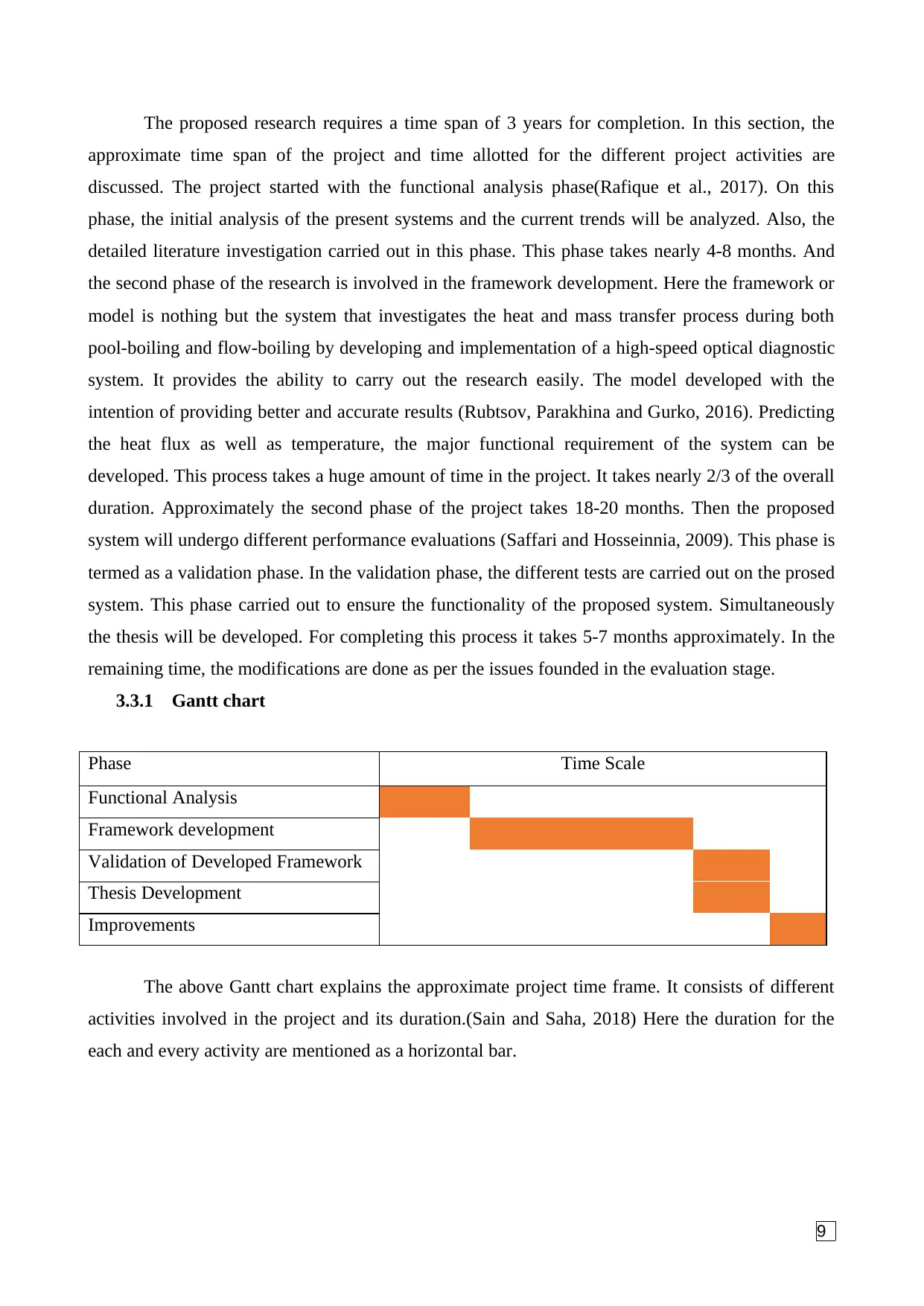
The proposed research requires a time span of 3 years for completion. In this section, the
approximate time span of the project and time allotted for the different project activities are
discussed. The project started with the functional analysis phase(Rafique et al., 2017). On this
phase, the initial analysis of the present systems and the current trends will be analyzed. Also, the
detailed literature investigation carried out in this phase. This phase takes nearly 4-8 months. And
the second phase of the research is involved in the framework development. Here the framework or
model is nothing but the system that investigates the heat and mass transfer process during both
pool-boiling and flow-boiling by developing and implementation of a high-speed optical diagnostic
system. It provides the ability to carry out the research easily. The model developed with the
intention of providing better and accurate results (Rubtsov, Parakhina and Gurko, 2016). Predicting
the heat flux as well as temperature, the major functional requirement of the system can be
developed. This process takes a huge amount of time in the project. It takes nearly 2/3 of the overall
duration. Approximately the second phase of the project takes 18-20 months. Then the proposed
system will undergo different performance evaluations (Saffari and Hosseinnia, 2009). This phase is
termed as a validation phase. In the validation phase, the different tests are carried out on the prosed
system. This phase carried out to ensure the functionality of the proposed system. Simultaneously
the thesis will be developed. For completing this process it takes 5-7 months approximately. In the
remaining time, the modifications are done as per the issues founded in the evaluation stage.
3.3.1 Gantt chart
Phase Time Scale
Functional Analysis
Framework development
Validation of Developed Framework
Thesis Development
Improvements
The above Gantt chart explains the approximate project time frame. It consists of different
activities involved in the project and its duration.(Sain and Saha, 2018) Here the duration for the
each and every activity are mentioned as a horizontal bar.
9
approximate time span of the project and time allotted for the different project activities are
discussed. The project started with the functional analysis phase(Rafique et al., 2017). On this
phase, the initial analysis of the present systems and the current trends will be analyzed. Also, the
detailed literature investigation carried out in this phase. This phase takes nearly 4-8 months. And
the second phase of the research is involved in the framework development. Here the framework or
model is nothing but the system that investigates the heat and mass transfer process during both
pool-boiling and flow-boiling by developing and implementation of a high-speed optical diagnostic
system. It provides the ability to carry out the research easily. The model developed with the
intention of providing better and accurate results (Rubtsov, Parakhina and Gurko, 2016). Predicting
the heat flux as well as temperature, the major functional requirement of the system can be
developed. This process takes a huge amount of time in the project. It takes nearly 2/3 of the overall
duration. Approximately the second phase of the project takes 18-20 months. Then the proposed
system will undergo different performance evaluations (Saffari and Hosseinnia, 2009). This phase is
termed as a validation phase. In the validation phase, the different tests are carried out on the prosed
system. This phase carried out to ensure the functionality of the proposed system. Simultaneously
the thesis will be developed. For completing this process it takes 5-7 months approximately. In the
remaining time, the modifications are done as per the issues founded in the evaluation stage.
3.3.1 Gantt chart
Phase Time Scale
Functional Analysis
Framework development
Validation of Developed Framework
Thesis Development
Improvements
The above Gantt chart explains the approximate project time frame. It consists of different
activities involved in the project and its duration.(Sain and Saha, 2018) Here the duration for the
each and every activity are mentioned as a horizontal bar.
9
Paraphrase This Document
Need a fresh take? Get an instant paraphrase of this document with our AI Paraphraser
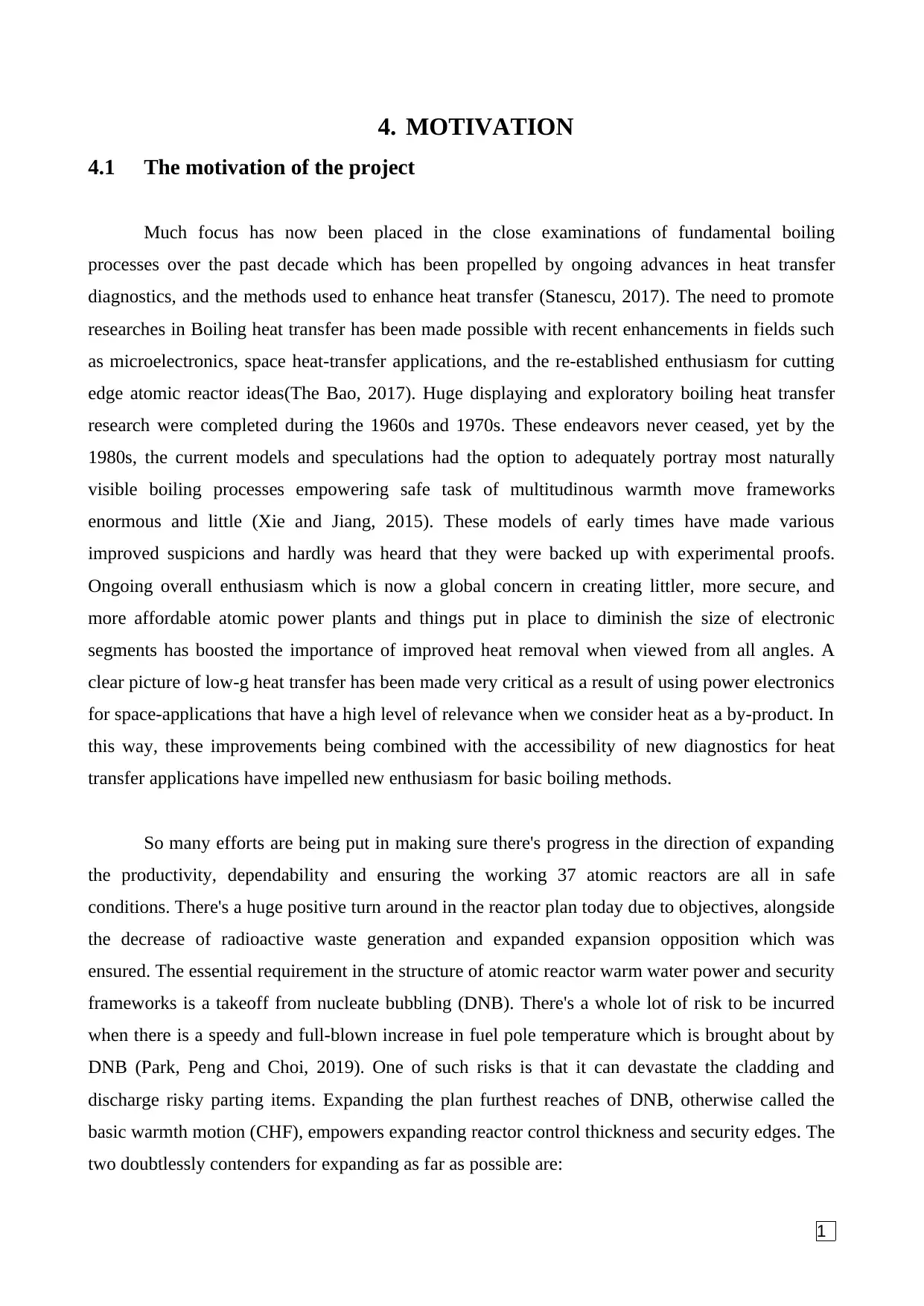
4. MOTIVATION
4.1 The motivation of the project
Much focus has now been placed in the close examinations of fundamental boiling
processes over the past decade which has been propelled by ongoing advances in heat transfer
diagnostics, and the methods used to enhance heat transfer (Stanescu, 2017). The need to promote
researches in Boiling heat transfer has been made possible with recent enhancements in fields such
as microelectronics, space heat-transfer applications, and the re-established enthusiasm for cutting
edge atomic reactor ideas(The Bao, 2017). Huge displaying and exploratory boiling heat transfer
research were completed during the 1960s and 1970s. These endeavors never ceased, yet by the
1980s, the current models and speculations had the option to adequately portray most naturally
visible boiling processes empowering safe task of multitudinous warmth move frameworks
enormous and little (Xie and Jiang, 2015). These models of early times have made various
improved suspicions and hardly was heard that they were backed up with experimental proofs.
Ongoing overall enthusiasm which is now a global concern in creating littler, more secure, and
more affordable atomic power plants and things put in place to diminish the size of electronic
segments has boosted the importance of improved heat removal when viewed from all angles. A
clear picture of low-g heat transfer has been made very critical as a result of using power electronics
for space-applications that have a high level of relevance when we consider heat as a by-product. In
this way, these improvements being combined with the accessibility of new diagnostics for heat
transfer applications have impelled new enthusiasm for basic boiling methods.
So many efforts are being put in making sure there's progress in the direction of expanding
the productivity, dependability and ensuring the working 37 atomic reactors are all in safe
conditions. There's a huge positive turn around in the reactor plan today due to objectives, alongside
the decrease of radioactive waste generation and expanded expansion opposition which was
ensured. The essential requirement in the structure of atomic reactor warm water power and security
frameworks is a takeoff from nucleate bubbling (DNB). There's a whole lot of risk to be incurred
when there is a speedy and full-blown increase in fuel pole temperature which is brought about by
DNB (Park, Peng and Choi, 2019). One of such risks is that it can devastate the cladding and
discharge risky parting items. Expanding the plan furthest reaches of DNB, otherwise called the
basic warmth motion (CHF), empowers expanding reactor control thickness and security edges. The
two doubtlessly contenders for expanding as far as possible are:
1
4.1 The motivation of the project
Much focus has now been placed in the close examinations of fundamental boiling
processes over the past decade which has been propelled by ongoing advances in heat transfer
diagnostics, and the methods used to enhance heat transfer (Stanescu, 2017). The need to promote
researches in Boiling heat transfer has been made possible with recent enhancements in fields such
as microelectronics, space heat-transfer applications, and the re-established enthusiasm for cutting
edge atomic reactor ideas(The Bao, 2017). Huge displaying and exploratory boiling heat transfer
research were completed during the 1960s and 1970s. These endeavors never ceased, yet by the
1980s, the current models and speculations had the option to adequately portray most naturally
visible boiling processes empowering safe task of multitudinous warmth move frameworks
enormous and little (Xie and Jiang, 2015). These models of early times have made various
improved suspicions and hardly was heard that they were backed up with experimental proofs.
Ongoing overall enthusiasm which is now a global concern in creating littler, more secure, and
more affordable atomic power plants and things put in place to diminish the size of electronic
segments has boosted the importance of improved heat removal when viewed from all angles. A
clear picture of low-g heat transfer has been made very critical as a result of using power electronics
for space-applications that have a high level of relevance when we consider heat as a by-product. In
this way, these improvements being combined with the accessibility of new diagnostics for heat
transfer applications have impelled new enthusiasm for basic boiling methods.
So many efforts are being put in making sure there's progress in the direction of expanding
the productivity, dependability and ensuring the working 37 atomic reactors are all in safe
conditions. There's a huge positive turn around in the reactor plan today due to objectives, alongside
the decrease of radioactive waste generation and expanded expansion opposition which was
ensured. The essential requirement in the structure of atomic reactor warm water power and security
frameworks is a takeoff from nucleate bubbling (DNB). There's a whole lot of risk to be incurred
when there is a speedy and full-blown increase in fuel pole temperature which is brought about by
DNB (Park, Peng and Choi, 2019). One of such risks is that it can devastate the cladding and
discharge risky parting items. Expanding the plan furthest reaches of DNB, otherwise called the
basic warmth motion (CHF), empowers expanding reactor control thickness and security edges. The
two doubtlessly contenders for expanding as far as possible are:
1
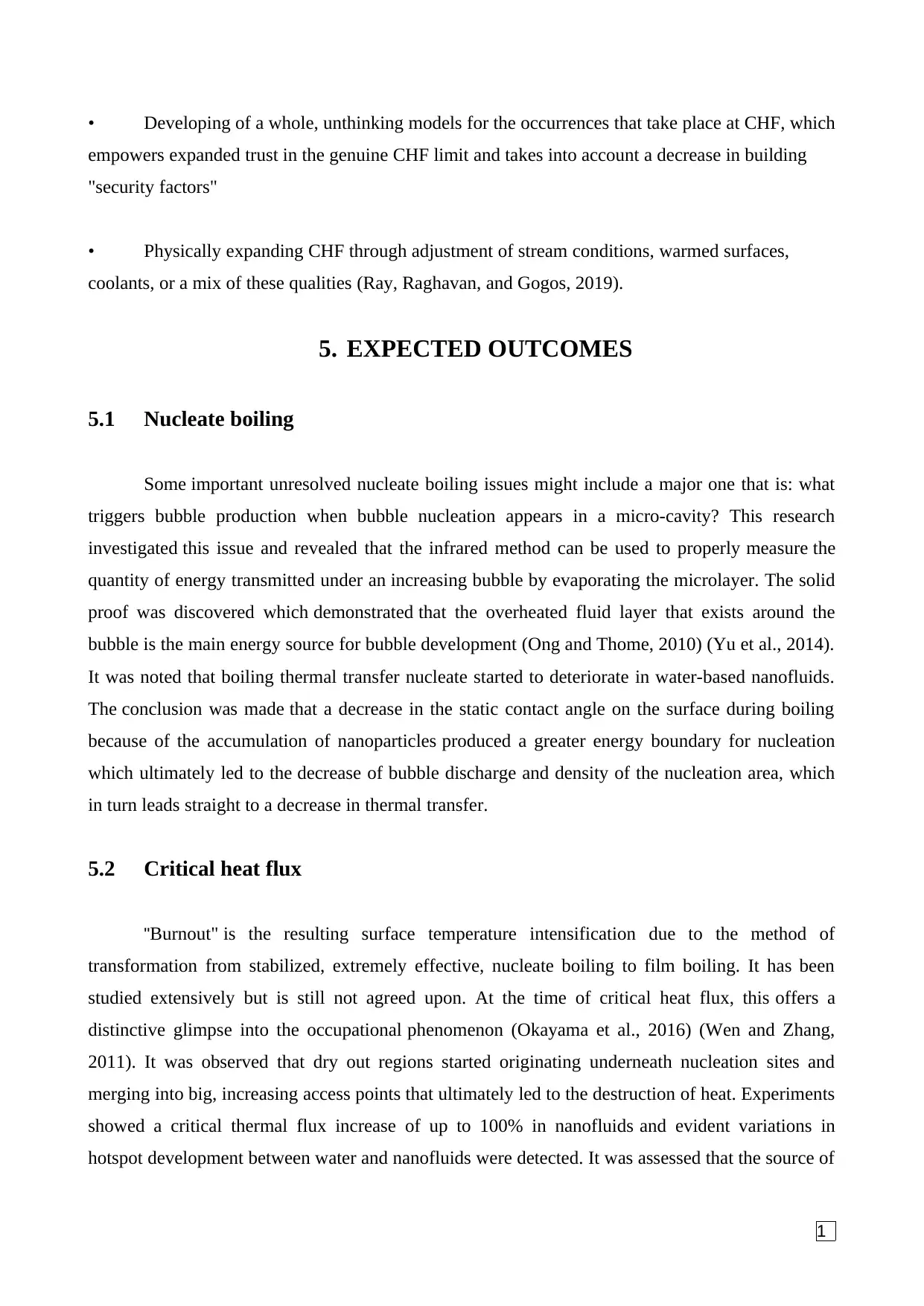
• Developing of a whole, unthinking models for the occurrences that take place at CHF, which
empowers expanded trust in the genuine CHF limit and takes into account a decrease in building
"security factors"
• Physically expanding CHF through adjustment of stream conditions, warmed surfaces,
coolants, or a mix of these qualities (Ray, Raghavan, and Gogos, 2019).
5. EXPECTED OUTCOMES
5.1 Nucleate boiling
Some important unresolved nucleate boiling issues might include a major one that is: what
triggers bubble production when bubble nucleation appears in a micro-cavity? This research
investigated this issue and revealed that the infrared method can be used to properly measure the
quantity of energy transmitted under an increasing bubble by evaporating the microlayer. The solid
proof was discovered which demonstrated that the overheated fluid layer that exists around the
bubble is the main energy source for bubble development (Ong and Thome, 2010) (Yu et al., 2014).
It was noted that boiling thermal transfer nucleate started to deteriorate in water-based nanofluids.
The conclusion was made that a decrease in the static contact angle on the surface during boiling
because of the accumulation of nanoparticles produced a greater energy boundary for nucleation
which ultimately led to the decrease of bubble discharge and density of the nucleation area, which
in turn leads straight to a decrease in thermal transfer.
5.2 Critical heat flux
"Burnout" is the resulting surface temperature intensification due to the method of
transformation from stabilized, extremely effective, nucleate boiling to film boiling. It has been
studied extensively but is still not agreed upon. At the time of critical heat flux, this offers a
distinctive glimpse into the occupational phenomenon (Okayama et al., 2016) (Wen and Zhang,
2011). It was observed that dry out regions started originating underneath nucleation sites and
merging into big, increasing access points that ultimately led to the destruction of heat. Experiments
showed a critical thermal flux increase of up to 100% in nanofluids and evident variations in
hotspot development between water and nanofluids were detected. It was assessed that the source of
1
empowers expanded trust in the genuine CHF limit and takes into account a decrease in building
"security factors"
• Physically expanding CHF through adjustment of stream conditions, warmed surfaces,
coolants, or a mix of these qualities (Ray, Raghavan, and Gogos, 2019).
5. EXPECTED OUTCOMES
5.1 Nucleate boiling
Some important unresolved nucleate boiling issues might include a major one that is: what
triggers bubble production when bubble nucleation appears in a micro-cavity? This research
investigated this issue and revealed that the infrared method can be used to properly measure the
quantity of energy transmitted under an increasing bubble by evaporating the microlayer. The solid
proof was discovered which demonstrated that the overheated fluid layer that exists around the
bubble is the main energy source for bubble development (Ong and Thome, 2010) (Yu et al., 2014).
It was noted that boiling thermal transfer nucleate started to deteriorate in water-based nanofluids.
The conclusion was made that a decrease in the static contact angle on the surface during boiling
because of the accumulation of nanoparticles produced a greater energy boundary for nucleation
which ultimately led to the decrease of bubble discharge and density of the nucleation area, which
in turn leads straight to a decrease in thermal transfer.
5.2 Critical heat flux
"Burnout" is the resulting surface temperature intensification due to the method of
transformation from stabilized, extremely effective, nucleate boiling to film boiling. It has been
studied extensively but is still not agreed upon. At the time of critical heat flux, this offers a
distinctive glimpse into the occupational phenomenon (Okayama et al., 2016) (Wen and Zhang,
2011). It was observed that dry out regions started originating underneath nucleation sites and
merging into big, increasing access points that ultimately led to the destruction of heat. Experiments
showed a critical thermal flux increase of up to 100% in nanofluids and evident variations in
hotspot development between water and nanofluids were detected. It was assessed that the source of
1
⊘ This is a preview!⊘
Do you want full access?
Subscribe today to unlock all pages.

Trusted by 1+ million students worldwide
1 out of 18
Related Documents
Your All-in-One AI-Powered Toolkit for Academic Success.
+13062052269
info@desklib.com
Available 24*7 on WhatsApp / Email
![[object Object]](/_next/static/media/star-bottom.7253800d.svg)
Unlock your academic potential
Copyright © 2020–2025 A2Z Services. All Rights Reserved. Developed and managed by ZUCOL.




